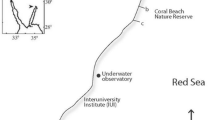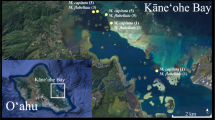Summary
Reproductive ecology of four scleractinian species, Lobophyllia corymbosa, Favia favus, Porties lutea and Porites australiensis was studied for two years on a patch reef near Lizard Island. Two major reproductive patterns were found: L. corymbosa and F. favus were simultaneous hermaphrodites and released gametes over several days in summer; and P. lutea, and P. australiensis were dioecious and released gametes over several weeks to several months respectively, in summer. Three of the four species spawned predominantly in the lunar period between the full and last quarter moon. In all four species, ovaries began developing several months earlier than testes. Number of ova per colony varied greatly amongst the species and was inversely related to mature egg size. The results presented here contrast with earlier assumptions of almost uniform viviparity of corals and supports the generalization that a brief annual spawning period with larvae developing externally may prove to be the dominant form of sexual reproduction in hermatypic corals.
Similar content being viewed by others
References
Atoda K (1947) The larva and postlarval development of some reef building corals. II. Stylophora pistillata (Esper). Sci Rep Tohoku Imp Univ Ser 418:48–64
Babcock RC (1980) The biology of Goniastrea aspera in the Townsville region. Honours thesis, James Cook University
Babcock RC (in preparation) Reproduction and dispersal of two species of reef-flat corals, Goniastrea aspera Verill and G. favulus Dana
Bothwell AM (in press) Fragmentation, a means of asexual reproduction and dispersal in the genus Acropora. Proc 4th Int Coral Reef Symp 2:137–144
Connell JH (1973) Population ecology of reef-building corals. In: Jones OA, Endean RE (eds) Biology and geology of coral reefs, vol 2. Academic Press, New York London, pp 205–245
Emlen JM (1972) Ecology: an evolutionary approach. Addison-Wesley Reading, Mass
Fisk DA (1981) Studies of two free-living corals and their common sipunculan associate at Wistari Reef (Great Barrier Reef). Master of Science thesis, University of Queensland
Giese AC, Pearse JS (1974) Reproduction of marine invertebrates, vol 2. Academic Press, New York London
Harrigan JF (1972) The planula larva of Pocillopora damicornis: lunar periodicity of swarming and substratum selection behavior. Ph D thesis, University of Hawaii
Harriott VJ (1980) The ecology of holothurian fauna of Heron Reef and Moreton Bay. Master of Science thesis, University of Queensland
Highsmith RC (1980) Passive colonization and asexual colony multiplication in the massive coral Porites lutea Milne Edwards and Haime. J Exp Mar Biol Ecol 47:55–67
Hyman LH (1940) The invertebrates. I. Protozoa through Ctenophora. McGraw-Hill, New York
Kojis BL, Quinn NJ (1981) Aspects of sexual reproduction and larval development in the shallow water hermatypic coral, Goniastrea australensis (Edwards and Haime 1857). Bull Mar Sci 31:558–573
Kojis BL, Quinn NJ (1982) Reproductive ecology of two faviid corals (Coelenterata: Scleractinia). Mar Ecol Prog Ser 8:251–255
Kojis BL, Quinn NJ (in press) Reproductive strategies in four species of Porites (Scleractinia). Proc 4th Int Coral Reef Symp 2:145–151
Lewis JB (1974) The settlement behaviour of planulae larvae of the hermatypic coral Favia fragum (Esper). J Exp Mar Biol Ecol 15:165–172
Loya Y (1976) The Red Sea coral Stylophora pistillata is an r strategist. Nature (London) 259:478–480
Luna LG (1968) Manual of histological staining methods of the Armed Forces Institute of Pathology, 3rd edn. McGraw-Hill, New York
Marshall SM, Stephenson TA (1933) The breeding of reef animals, pt 1: The corals. Sci Rep Great Barrier Reef Exped 3:219–245
Oliver JK (1979) Temporal and spatial variations in the growth of Acropora formosa (Dana 1846) on a North Queensland fringing reef. Honours thesis, James Cook University
Oliver JK (in preparation) Sexual reproduction in Acropora formosa: seasonality and synchrony of gametogenesis
Orton JH (1920) Sea-temperature, breeding and distribution in marine animals. J Mar Biol Assoc UK 12:339–366
Rae JG (1978) Reproduction in two sympatric species of Macoma (Bivalvia). Biol Bull 155:207–219
Rinkevich B, Loya Y (1979a) The reproduction of the Red Sea coral Stylophora pistillata. I. Gonads and planulae. Mar Ecol Prog Ser 1:113–144
Rinkevich B, Loya Y (1979b) The reproduction of the Red Sea coral Stylophora pistillata. II. Synchronization in breeding and seasonality of planulae release. Mar Ecol Prog Ser 1:145–152
Rosen BR (1981) The tropical high diversity enigma — the coral's eye view. In: Forey DL (ed) The evolving biosphere. British Museum (Natural History), Cambridge University Press, London, pp 103–130
Stearns SC (1976) Life history tactics: a revies of the ideas. Q Rev Biol 51:3–47
Stimson JS (1976) Reproduction in some common Hawaiian reef corals. In: Mackie GO (ed) Coelenterate ecology and behaviour. Plenum Press, New York, pp 271–279
Stimson JS (1978) Mode and timing of reproduction in some common hermatypic corals of Hawaii and Enewetak. Mar Biol 48:173–184
Szmant-Froelich A, Yevich P, Pilson MEQ (1980) Gametogenesis and early development of the temperature coral Astrangia danae (Anthozoa: Scleractinia). Biol Bull 158:257–269
Veron JEN, Pichon M (in press) Scleractinia of Eastern Australia. Part IV. Family Poritidae. A.I.M.S. Monogr Ser, vol 5
Walker TA (1981) Annual temperature cycles in Cleveland Bay, Great Barrier Reef Province. Aust J Mar Freshwater Res 32:987–991
Willis BL (in preparation) Reproductive ecology of Turbinaria mesenterina — a dioecious autumn/winter spawner
Author information
Authors and Affiliations
Rights and permissions
About this article
Cite this article
Harriott, V.J. Reproductive ecology of four scleratinian species at Lizard Island, Great Barrier Reef. Coral Reefs 2, 9–18 (1983). https://doi.org/10.1007/BF00304727
Received:
Accepted:
Issue Date:
DOI: https://doi.org/10.1007/BF00304727




